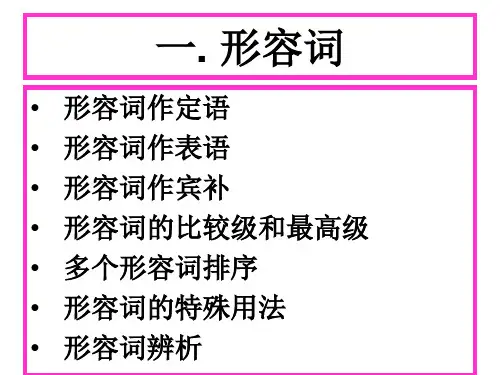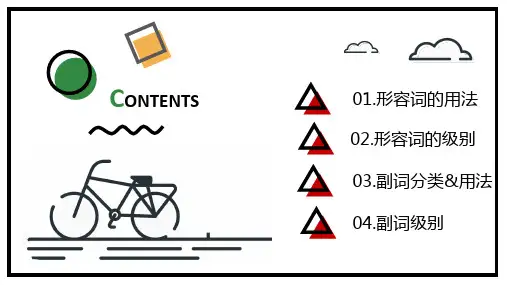形容词和副词ppt课件
合集下载
形容词和副词公开课PPT课件

比较级和最高级错误
与形容词类似,副词也有比较级和最高级形式,需注意正 确使用。例如,“更快”而非“快er”,“最慢”而非 “慢est”。
避免常见误区和注意事项
避免过度使用形容词和副词
过多的形容词和副词会使句子显得累赘,影响表达效果。应力求 简洁明了,仅在必要时使用。
注意语境和表达习惯
形容词和副词的使用需根据具体语境和表达习惯进行调整,避免生 搬硬套。
04
形容词和副词在句子中运用
形容词在句子中位置和作用
01 形容词定义
描述名词或代词性质、状态或特征的词。
02 形容词在句子中的位置
通常位于名词前,如“美丽的花园”中的“美丽 ”。
03 形容词的作用
使句子更加生动形象,帮助读者或听者更好地理 解和想象所描述的事物。
副词在句子中位置和作用
副词定义
修饰动词、形容词、其他 副词或整个句子的词。
形容词分类及举例
品质形容词
描述人或事物的品质或特 征,如“美丽的”、“善 良的”。
数量形容词
描述人或事物的数量或程 度,如“许多”、“一些 ”。
指示形容词
用来指示特定的人或事物 ,如“这个”、“那个” 。
疑问形容词
用来引导疑问句,询问人 或事物的性质、特征或状 态,如“什么样的”、“ 怎样的”。
常见易混淆形容词辨析
• 比较级
单音节词和部分双音节词 通过加-er和-est构成比较 级和最高级;多音节词和 部分双音节词通过加more 和most构成比较级和最高 级。
John is taller than Tom. (约翰比汤姆高。)
05 • 最高级
Of all the students in the class, Mary studies the hardest.(在班上所有学生 中,玛丽学习最努力。)
与形容词类似,副词也有比较级和最高级形式,需注意正 确使用。例如,“更快”而非“快er”,“最慢”而非 “慢est”。
避免常见误区和注意事项
避免过度使用形容词和副词
过多的形容词和副词会使句子显得累赘,影响表达效果。应力求 简洁明了,仅在必要时使用。
注意语境和表达习惯
形容词和副词的使用需根据具体语境和表达习惯进行调整,避免生 搬硬套。
04
形容词和副词在句子中运用
形容词在句子中位置和作用
01 形容词定义
描述名词或代词性质、状态或特征的词。
02 形容词在句子中的位置
通常位于名词前,如“美丽的花园”中的“美丽 ”。
03 形容词的作用
使句子更加生动形象,帮助读者或听者更好地理 解和想象所描述的事物。
副词在句子中位置和作用
副词定义
修饰动词、形容词、其他 副词或整个句子的词。
形容词分类及举例
品质形容词
描述人或事物的品质或特 征,如“美丽的”、“善 良的”。
数量形容词
描述人或事物的数量或程 度,如“许多”、“一些 ”。
指示形容词
用来指示特定的人或事物 ,如“这个”、“那个” 。
疑问形容词
用来引导疑问句,询问人 或事物的性质、特征或状 态,如“什么样的”、“ 怎样的”。
常见易混淆形容词辨析
• 比较级
单音节词和部分双音节词 通过加-er和-est构成比较 级和最高级;多音节词和 部分双音节词通过加more 和most构成比较级和最高 级。
John is taller than Tom. (约翰比汤姆高。)
05 • 最高级
Of all the students in the class, Mary studies the hardest.(在班上所有学生 中,玛丽学习最努力。)
初中英语语法——形容词和副词-精(共18张)ppt课件

3
作定语,放在名词之前,不定代词之后
完整最新ppt
4
n ...的人 -al 有...属性的
-ful ...的
-y 充满...的,多...的 -ern ...方位的 -less 无...的
完整最新ppt
-en ...材质的 -able 可能的,可以的
5
副词是一种用来修饰动词,形容 词,副词或全句的词,说明时间,地点, 程度,方式等概念。
比较级
more slowly more quickly more angrily more softly more noisily
最高级
most slowly most quickly most angrily most softly most noisily
由ing分词和ed分词演变过来的形容词(包括不规 则动词如know→known)只能加more或most来表
more更多的;更
less更少的 farther更远的;更远地
further进一步的(地)
most最多的;最
least最少的 farthest最远的;最远地
furthest最深刻的(地)
完整最新ppt
15
①表示两者进行比较时用形容词比较级,其结构为“A…+比较级+ than+B”。 ②有表示程度的副词a little, a bit, a few, a lot, much, even, still, far, rather, any等修饰时,用形容词比较级。 ③表示两者之间进行选择“哪一个更……”时,用句型“Which/ Who is +形容词比较级,A or B?”表示。 ④表示“几倍于……”时,用“倍数+ 比较级+ than”表示。 ⑤表示“两者之间最……一个(of the two)”时,常用“the+比较级”结构。 ⑥表示“越来越……”,用比较级重叠结构,即“比较级+ and +比较级”,多音节词和部分双音节词时用“more and more +形容词原级” ⑦表示“越……就越……”时,用“the+比较级,the+比较级”结构。 ⑧在两者进行比较“表示A不如B”时,部分双音节和多音节副词除使用“not…as/ so +副词原级+as”结构外, 还可使用“less +副词原级+than”结构。 ⑨副词最高级前一般不加定冠词the。
作定语,放在名词之前,不定代词之后
完整最新ppt
4
n ...的人 -al 有...属性的
-ful ...的
-y 充满...的,多...的 -ern ...方位的 -less 无...的
完整最新ppt
-en ...材质的 -able 可能的,可以的
5
副词是一种用来修饰动词,形容 词,副词或全句的词,说明时间,地点, 程度,方式等概念。
比较级
more slowly more quickly more angrily more softly more noisily
最高级
most slowly most quickly most angrily most softly most noisily
由ing分词和ed分词演变过来的形容词(包括不规 则动词如know→known)只能加more或most来表
more更多的;更
less更少的 farther更远的;更远地
further进一步的(地)
most最多的;最
least最少的 farthest最远的;最远地
furthest最深刻的(地)
完整最新ppt
15
①表示两者进行比较时用形容词比较级,其结构为“A…+比较级+ than+B”。 ②有表示程度的副词a little, a bit, a few, a lot, much, even, still, far, rather, any等修饰时,用形容词比较级。 ③表示两者之间进行选择“哪一个更……”时,用句型“Which/ Who is +形容词比较级,A or B?”表示。 ④表示“几倍于……”时,用“倍数+ 比较级+ than”表示。 ⑤表示“两者之间最……一个(of the two)”时,常用“the+比较级”结构。 ⑥表示“越来越……”,用比较级重叠结构,即“比较级+ and +比较级”,多音节词和部分双音节词时用“more and more +形容词原级” ⑦表示“越……就越……”时,用“the+比较级,the+比较级”结构。 ⑧在两者进行比较“表示A不如B”时,部分双音节和多音节副词除使用“not…as/ so +副词原级+as”结构外, 还可使用“less +副词原级+than”结构。 ⑨副词最高级前一般不加定冠词the。
第5讲形容词和副词ppt课件

天变得越来越黑. 情况一天比一天好起来.
• It’s getting darker and darker. • Things are getting better and
better everyday.
认识到了贫困户贫困的根本原因,才 能开始 对症下 药,然 后药到 病除。 近年来 国家对 扶贫工 作高度 重视, 已经展 开了“ 精准扶 贫”项 目
认识到了贫困户贫困的根本原因,才 能开始 对症下 药,然 后药到 病除。 近年来 国家对 扶贫工 作高度 重视, 已经展 开了“ 精准扶 贫”项 目
3. 形容词作宾补
• Running in the morning makes him strong.
• We think the film really interesting. • Who has left the door open? • I found her asleep on the grass.
形容词作宾补指的是形容词修饰补充说明宾语.
认识到了贫困户贫困的根本原因,才 能开始 对症下 药,然 后药到 病除。 近年来 国家对 扶贫工 作高度 重视, 已经展 开了“ 精准扶 贫”项 目
形容词作宾补
主语+谓语+宾语+形容词(作宾补)
• 请保持教室清洁.
Please keep the classroom clean.
• This tree is 3 times as tall as that tree.
认识到了贫困户贫困的根本原因,才 能开始 对症下 药,然 后药到 病除。 近年来 国家对 扶贫工 作高度 重视, 已经展 开了“ 精准扶 贫”项 目
• 我觉得这个故事很有趣.
I found the story interesting.
• It’s getting darker and darker. • Things are getting better and
better everyday.
认识到了贫困户贫困的根本原因,才 能开始 对症下 药,然 后药到 病除。 近年来 国家对 扶贫工 作高度 重视, 已经展 开了“ 精准扶 贫”项 目
认识到了贫困户贫困的根本原因,才 能开始 对症下 药,然 后药到 病除。 近年来 国家对 扶贫工 作高度 重视, 已经展 开了“ 精准扶 贫”项 目
3. 形容词作宾补
• Running in the morning makes him strong.
• We think the film really interesting. • Who has left the door open? • I found her asleep on the grass.
形容词作宾补指的是形容词修饰补充说明宾语.
认识到了贫困户贫困的根本原因,才 能开始 对症下 药,然 后药到 病除。 近年来 国家对 扶贫工 作高度 重视, 已经展 开了“ 精准扶 贫”项 目
形容词作宾补
主语+谓语+宾语+形容词(作宾补)
• 请保持教室清洁.
Please keep the classroom clean.
• This tree is 3 times as tall as that tree.
认识到了贫困户贫困的根本原因,才 能开始 对症下 药,然 后药到 病除。 近年来 国家对 扶贫工 作高度 重视, 已经展 开了“ 精准扶 贫”项 目
• 我觉得这个故事很有趣.
I found the story interesting.
形容词和副词(共19张PPT)

04
形容词和副词的特殊用法
形容词的特殊用法
形容词作名词
形容词的比较级和最高级
某些形容词可以作为名词使用,如“ 幸福”、“成功”等,表示一种状态 或结果。
形容词有比较级和最高级的用法,用 于描述程度或数量的差异,如“更快 ”、“最高”等。
形容词修饰名词
形容词可以放在名词前面,用来描述 名词的特征或属性,如“美丽的花朵 ”、“高大的建筑”等。
详细描述
副词用于描述动词、形容词或其他副词的行为方式、程度、时间、频率等,对于准确表达动作或状态的细节至关 重要。通过副词选择题,可以练习副词在不同语境中的用法,如描述动作发生的时间、方式、频率等,判断副词 的正确用法和意义。
综合练习
总结词
提高综合运用形容词和副词的能力
详细描述
综合练习是将形容词和副词结合在一起使用的练习方式,通过设置语境和情境,让学生根据上下文选 择合适的形容词和副词,以增强学生对形容词和副词的理解和应用能力。综合练习可以包括填空、改 错、翻译等形式,让学生在实际运用中提高对形容词和副词的掌握程度。
副词的比较级和最高级
副词的比较级
用于描述动作、状态或方式在两个或更多的人或事物之间的 相对差异。通常在副词后加“-er”或“more + 副词原形” 构成比较级。例如,“faster”和“more beautifully”。
副词的最高级
用于描述动作、状态或方式在三个或更多的人或事物中的最 高或最低程度。通常在副词后加“-est”或“most + 副词原 形”构成最高级。例如,“fastest”和“most beautifully”。
THANK YOU
ห้องสมุดไป่ตู้感谢各位观看
表示动作的程度,如“very”、 “too”、“quite”、“almost”等 。
形容词和副词PPT课件

A house smells as if it hasn’t
lived in for years.
A. little white wooden B. little wooden white
C. white wooden little D. wooden white little
4) A Students are required to take part in
4. The apple tastes __C___ and sells ___ .
A. well; well
B. good; good
C. good; well
D. well; good
5. Your answer sounds __A___ .
A. correct C. correctness
certain表示“某”时,只能用作定语:a certain
person 某人。
例题:
1. She was _____ (luck) to lose her money when she went shopping last weekend. [04西宁]
答案点拨:was是系动词,其后要跟形容词作表语, luck的形容词形式为lucky,但我们填上后发现句意不通: 丢了钱她还能幸运吗?肯定是“不幸”,故应填它的反 义词unlucky。 2. This kind of skirt looks __ and sells__. [04天津]
3.—What do you think of the story written by Mark
Twain?
—It is ________. I like it. [04昆明]
A. boring
英语形容词和副词ppt课件

He made us happy.
做状语
作状语,表示伴随、原因、结果等。
eg.He went to bed , cold and hungry .
She后置:
A. 修饰some, any, no, every 等构成的复合不定代词要后置。 something new; nothing serious; anything interesting
PART TWO
形容词级别
1.规则形容词的比较级和最高级(4种)
⑴直接加-er , -est :
young
clever
brave
younger cleverer
braver
youngest cleverest
bravest
⑵辅音字母 + y 结尾的变 y 为 i 再加 -er、-est :
happy
B.interesting,be interested
C. interested; be interesting D. interesting; interest
3.I’m very_____ on hearing the_______ news.
A.surprised, surprising B.surprising, surprised
............的
1.通常放在名词之前
a blue cap
a big orange
形容词既可修饰单数也可修饰复数
a red strawberry three red strawberries
2.可以放在 be 动词之后 This suit is yellow. These suits are yellow. The apple is red . The apples are red .
做状语
作状语,表示伴随、原因、结果等。
eg.He went to bed , cold and hungry .
She后置:
A. 修饰some, any, no, every 等构成的复合不定代词要后置。 something new; nothing serious; anything interesting
PART TWO
形容词级别
1.规则形容词的比较级和最高级(4种)
⑴直接加-er , -est :
young
clever
brave
younger cleverer
braver
youngest cleverest
bravest
⑵辅音字母 + y 结尾的变 y 为 i 再加 -er、-est :
happy
B.interesting,be interested
C. interested; be interesting D. interesting; interest
3.I’m very_____ on hearing the_______ news.
A.surprised, surprising B.surprising, surprised
............的
1.通常放在名词之前
a blue cap
a big orange
形容词既可修饰单数也可修饰复数
a red strawberry three red strawberries
2.可以放在 be 动词之后 This suit is yellow. These suits are yellow. The apple is red . The apples are red .
高中英语语法:形容词和副词(共61张PPT)
一、形容词和副词的句法功能
1.作定语 形容词作定语一般位于被修饰词的前面;副词作定语多表示时间 或地点,位于被修饰词的后面。 Widespread poverty in Africa means that many people there cannot get the water, clothing, housing, electricity, or education they need.非 洲普遍的贫穷意味着那里的许多人不能获得他们需要的饮用水、 衣服、房屋、电力及教育。 The people there were friendly.那儿的人很友好。(副词作定语须 后置)
the English英国人
(2)“the+形容词”表示抽象概念,作主语时谓语动词用单数。
the best最好的情况
the unknown未知的事
the impossible不可能的事
the right正确的事
二、形容词和副词的位置
1.形容词的位置 (1)一般情况下,单个形容词都位于所修饰的名词前。
一二、介 形词 容的 词分 和类副词的位置
(3)形容词也可位于被修饰名词之后。
③两个意义相近或相反的形容词用and, or或but连接,作定语时须后 置。 Power stations, large or small, have been set up all over the country.大大 小小的发电站已经在全国建立起来了。 All the people on this island, young or old, are fond of music.这个岛上的 老老少少都喜欢音乐。(意义相反。) ④当“形容词+不定式”构成的短语作定语时。 A man so difficult to please must be hard to work with.一个如此难以取悦 的人一定很难共事。 He enjoys the music pleasant to listen to.他很喜欢这首听起来很好听的 音乐。
形容词和副词英语语法讲解PPT
个句子。如:
• He had worked hard all his life .(修饰动词) • He is very diligent.(修饰形容词)
• You can find books on that subject quite easily .(修饰副词)
• Luckily she was in when I called .(修饰句 子)
比较级 1. 构成形式: - er
注意不规则变化
原级
比较级
much/many more ill/bad/badly worse
little
less
good / well better
far
farther
st worst least best farthest furthest
1.She doesn’t speak_A__ her friends, but her written work is excellent.
1.This ____A___ girl is Lind’s cousin.
A. pretty little Spanish
B. Spanish little pretty
C. Spanish pretty little D. little pretty Spanish
2. One day they crossed the __A__bridge behind the palace.
E. 某些形容词,如: present (在场的,出席的), involved(有关的), concerned (相关的), left (剩下 的), mentioned (提及的), selected (当选的)等。 如: the students present (出席的学生)
• He had worked hard all his life .(修饰动词) • He is very diligent.(修饰形容词)
• You can find books on that subject quite easily .(修饰副词)
• Luckily she was in when I called .(修饰句 子)
比较级 1. 构成形式: - er
注意不规则变化
原级
比较级
much/many more ill/bad/badly worse
little
less
good / well better
far
farther
st worst least best farthest furthest
1.She doesn’t speak_A__ her friends, but her written work is excellent.
1.This ____A___ girl is Lind’s cousin.
A. pretty little Spanish
B. Spanish little pretty
C. Spanish pretty little D. little pretty Spanish
2. One day they crossed the __A__bridge behind the palace.
E. 某些形容词,如: present (在场的,出席的), involved(有关的), concerned (相关的), left (剩下 的), mentioned (提及的), selected (当选的)等。 如: the students present (出席的学生)
- 1、下载文档前请自行甄别文档内容的完整性,平台不提供额外的编辑、内容补充、找答案等附加服务。
- 2、"仅部分预览"的文档,不可在线预览部分如存在完整性等问题,可反馈申请退款(可完整预览的文档不适用该条件!)。
- 3、如文档侵犯您的权益,请联系客服反馈,我们会尽快为您处理(人工客服工作时间:9:00-18:30)。
9
The trees turn green in spring. We are alonபைடு நூலகம் on the island.
只能作表语,不能作定语的形容词 你能说出几个?
alone afraid awake asleep alive able alike awake ill
10
形容词和宾语一起构成复合 宾语.e.g. We must keep the classroom clean.
三种
14
Let’s fill in the blanks,
15
taller h原ar级tdaellrest 比ha较rde最st高
单es音t(最节高词词级在)词以尾尾字加母-ee接变r(比尾较的级词化)加l或a-rbf-rga或iegtt-rgewtlerbhwaahrrloiwielggdlahhteategtepatorwetererpgdttissdestieteeetrtsfrstat级twteisdte级st
19
(4) 否定 not as+形容词原形+as “和… 不一样”
或 not so+形容词原形+as “不及/不如…
Tom is not as tall as Mike.
Tom is not so tall as Mike.
20
(1) A+ be\v.+ 比较级+than…+B
Our school is larger than theirs. This bridge is longer than that one.
He made us happy.
Color it green.
11
词类 用法
举例
位置
作表语 My mother is out .
?
副 作定语 The girl there is my ?
friend.
词 作状语 He runs fast .
?
作宾补 I found him outside. ?
12
词可加-er或-est
mocrleevserlowly
多音节词和多数双音节词在其前面 difficult
加more 和most
popular
16
slowly
原级 比较级
good well bad ill many much little Far old
better
worse
more less farther/further older/elder
st
hapdpriieersdt reiaerliest
以个或以或少e-重辅辅数ess读音音t以t 闭字字-e音母母r,-节应+oyw结双结结尾写尾尾的辅的的词音词双末字变音尾母为节只再i再有加加一e-rmmeer,aoobthenrrrhaliaaeegiirprnemmmnclrpydpohfrlayawoeoooiotfrdtvsssfpwrriyoettteuctrwpsdulncealoillearofrtepfrrwvirucoelulyrwaelrtesst t
2、特殊句型。
(下节课讲)
3、易混词的辨析。
4
5
I.形容词和副词的概念及功能
形容词(Adj.):说明人 和事物特征,性质 或状态的词。
副词(Adv.):用来说明 时间,地点,程度,方 式等概念的词。
e.g. long, empty,
e.g. very, early, out,
cheap, hungry, etc.
形容词和副词的用法
1
2
3
Teaching aims:
• 1.Adj.和Adv的概念,功能及位置(重点)
• 2.Adj.和Adv.的种类
及Adj.和Adv.的构成 (重点)
• 3.Adj.和 Adv.比较等级的用法(重难点)
• 4.Adj.变Adv.的规律(重点)
• [考点]:1、构成,用法,规律。
Fire makes us hot .
形容词放在宾语后,作 宾语补足语
It feels
sad .
形容词与系动词连用, 作表语
8
e.g. He is a good student. I have something important to tell you. 当形容词修饰由some-,any-,no-,every构成的不定代词时,形容词要放在这些 不定代词的之后. e.g. Is there anything interesting in today’s newspaper ?
最高级
best
worst most least farthest/furthest oldest/eldest
17
• P67 • 1.少数形容词只能作表语,不能作定语。 • 2.频率副词作状语时,放在系动词,助动词
情态动词之后,行为动词之前 • 3.某些副词强调上下句衔接时,可放在句首 • 4.enough修饰adj.和adv.时,放在其后.
18
III. Adj.和Adv.比较等级的用法
(1)as+形容词原形+as
Tom is as tall as Mike. (2) 倍数 Tom is three times as old as Mike. (3)半数 Tom is half as tall as Mike.
There are as many students in our school as yours.
副词是用来修饰动词, 形容词,其他副词或句子
的词。位置灵活。
1. He runs quickly. (副词修饰动词) 2. She is very beautiful.(副词修饰形容词)
3. Luckily, he was not badly hurt. (副词修饰句子)
13
II. 形容词和副词的 1.种类
(2) A+ +比较级+than…+B
a little, much ,even, stiil,far ect.
21
(3)表示两者之间的选择,可使用 “Which is+ 比较级,…or…?”
soon, quickly, etc.
用来修饰名词 或代词
用来修饰形容词, 动词,副词或整个 句子
6
词 用法
位置
类
形 作定语 放在名词前,
容
不定代词后
词 作表语 放在系动词之后
举例
? ?
adj 作补语 放在宾语之后,常与
?
keep,make,get等词连用
7
Chinese medicine
形容词放在名词前做定语
The trees turn green in spring. We are alonபைடு நூலகம் on the island.
只能作表语,不能作定语的形容词 你能说出几个?
alone afraid awake asleep alive able alike awake ill
10
形容词和宾语一起构成复合 宾语.e.g. We must keep the classroom clean.
三种
14
Let’s fill in the blanks,
15
taller h原ar级tdaellrest 比ha较rde最st高
单es音t(最节高词词级在)词以尾尾字加母-ee接变r(比尾较的级词化)加l或a-rbf-rga或iegtt-rgewtlerbhwaahrrloiwielggdlahhteategtepatorwetererpgdttissdestieteeetrtsfrstat级twteisdte级st
19
(4) 否定 not as+形容词原形+as “和… 不一样”
或 not so+形容词原形+as “不及/不如…
Tom is not as tall as Mike.
Tom is not so tall as Mike.
20
(1) A+ be\v.+ 比较级+than…+B
Our school is larger than theirs. This bridge is longer than that one.
He made us happy.
Color it green.
11
词类 用法
举例
位置
作表语 My mother is out .
?
副 作定语 The girl there is my ?
friend.
词 作状语 He runs fast .
?
作宾补 I found him outside. ?
12
词可加-er或-est
mocrleevserlowly
多音节词和多数双音节词在其前面 difficult
加more 和most
popular
16
slowly
原级 比较级
good well bad ill many much little Far old
better
worse
more less farther/further older/elder
st
hapdpriieersdt reiaerliest
以个或以或少e-重辅辅数ess读音音t以t 闭字字-e音母母r,-节应+oyw结双结结尾写尾尾的辅的的词音词双末字变音尾母为节只再i再有加加一e-rmmeer,aoobthenrrrhaliaaeegiirprnemmmnclrpydpohfrlayawoeoooiotfrdtvsssfpwrriyoettteuctrwpsdulncealoillearofrtepfrrwvirucoelulyrwaelrtesst t
2、特殊句型。
(下节课讲)
3、易混词的辨析。
4
5
I.形容词和副词的概念及功能
形容词(Adj.):说明人 和事物特征,性质 或状态的词。
副词(Adv.):用来说明 时间,地点,程度,方 式等概念的词。
e.g. long, empty,
e.g. very, early, out,
cheap, hungry, etc.
形容词和副词的用法
1
2
3
Teaching aims:
• 1.Adj.和Adv的概念,功能及位置(重点)
• 2.Adj.和Adv.的种类
及Adj.和Adv.的构成 (重点)
• 3.Adj.和 Adv.比较等级的用法(重难点)
• 4.Adj.变Adv.的规律(重点)
• [考点]:1、构成,用法,规律。
Fire makes us hot .
形容词放在宾语后,作 宾语补足语
It feels
sad .
形容词与系动词连用, 作表语
8
e.g. He is a good student. I have something important to tell you. 当形容词修饰由some-,any-,no-,every构成的不定代词时,形容词要放在这些 不定代词的之后. e.g. Is there anything interesting in today’s newspaper ?
最高级
best
worst most least farthest/furthest oldest/eldest
17
• P67 • 1.少数形容词只能作表语,不能作定语。 • 2.频率副词作状语时,放在系动词,助动词
情态动词之后,行为动词之前 • 3.某些副词强调上下句衔接时,可放在句首 • 4.enough修饰adj.和adv.时,放在其后.
18
III. Adj.和Adv.比较等级的用法
(1)as+形容词原形+as
Tom is as tall as Mike. (2) 倍数 Tom is three times as old as Mike. (3)半数 Tom is half as tall as Mike.
There are as many students in our school as yours.
副词是用来修饰动词, 形容词,其他副词或句子
的词。位置灵活。
1. He runs quickly. (副词修饰动词) 2. She is very beautiful.(副词修饰形容词)
3. Luckily, he was not badly hurt. (副词修饰句子)
13
II. 形容词和副词的 1.种类
(2) A+ +比较级+than…+B
a little, much ,even, stiil,far ect.
21
(3)表示两者之间的选择,可使用 “Which is+ 比较级,…or…?”
soon, quickly, etc.
用来修饰名词 或代词
用来修饰形容词, 动词,副词或整个 句子
6
词 用法
位置
类
形 作定语 放在名词前,
容
不定代词后
词 作表语 放在系动词之后
举例
? ?
adj 作补语 放在宾语之后,常与
?
keep,make,get等词连用
7
Chinese medicine
形容词放在名词前做定语
